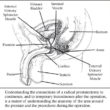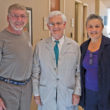Get Moving, Get Healthy, Reduce Your Cancer Risk
For the first time since 2012, the American Cancer Society (ACS) updated its guidelines for diet and physical activity, emphasizing individual choices that could reduce cancer risks. The guidelines are based on the latest available evidence.

Take the long view of your life: the steps you take now can expand your horizons in the future.
The ACS said that at least 18% of all cancers and about 16% of cancer deaths in the U.S. are related to excess body weight, lack of physical activity, alcohol consumption, and/or poor nutrition. Following the ACS recommendations could potentially prevent many of these cancers or cancer deaths.
Healthy weight
The recommendations include avoiding excess weight gain and maintaining a healthy weight. The World Health Organization defines a BMI of 25 to 29.9 as overweight, and a BMI of 30 or greater is obese. The BMI is a calculation of weight relative to height (kg/m2).
Stay active
Exercise is also important. The ACS recommends that adults should have 150 to 300 minutes of moderate activity or 75 to 100 minutes of vigorous exercise each week. Related, limiting sedentary activity could help reduce cancer risks.
Eat well
In addition, a healthy diet may help reduce risk of developing or dying from cancer. The ACS recommends following a diet that is primarily plant-based, and limiting red and processed meats, alcoholic and sugar-sweetened drinks, highly processed foods, and refined grain products.
Impact on prostate cancer
The full ACS guidelines, published in CA: A Cancer Journal for Clinicians, noted that for prostate cancer specifically, excess body fat increases the risk of advanced prostate cancer, and a higher consumption of dairy products and calcium may increase the risk of developing the disease. They study also noted some limited evidence suggesting that lower consumption of red and processed meat was associated with a lower risk of prostate cancer death.
A patient-friendly version of the guidelines is available online here.
Additional research points to the importance of a healthy lifestyle
Further supporting the goal of maintaining a healthy weight through diet and exercise, a study published earlier this year linked being overweight in middle age and late adulthood to a greater risk of advanced prostate cancer. A BMI higher than the healthy range was associated with a greater risk of developing advanced prostate cancer, as was having a larger waist size. A healthy weight is considered between 21 and 25 kg/m2.

“This study shows that adopting and maintaining healthy weight in middle to late adulthood can especially reduce risk of advanced prostate cancer,” said Jeanine Genkinger, PhD, an epidemiologist at Columbia University Mailman School of Public Health.
The study reviewed data from 15 large studies combined together, including 830,772 men, 51,734 of whom had been diagnosed with prostate cancer.
In addition, a study released this summer from researchers at The University of Texas MD Anderson Cancer Center found a correlation between sedentary behaviors and a higher risk of dying from cancer. The people in the study who were the most sedentary had an 82% higher risk of cancer mortality compared to people who were the least sedentary.
The study also found that replacing 30 minutes of sedentary time with moderate physical activity, such as biking, was associated with a 31% lower risk of cancer death. There was even an 8% benefit for replacing 30 minutes of sedentary time with light activity, such as walking.
Our findings reinforce that it’s important to ‘sit less and move more’ and that incorporating 30 minutes of movement into your daily life can help reduce your risk of death from cancer. – Susan Gilchrist, M.D., of University of Texas MD Anderson Cancer Center
Ann Oncol. 2020 Jan;31(1):103-114. doi: 10.1016/j.annonc.2019.09.007.
JAMA Oncol. 2020 Jun 18;e202045. doi: 10.1001/jamaoncol.2020.2045. Online ahead of print.





















